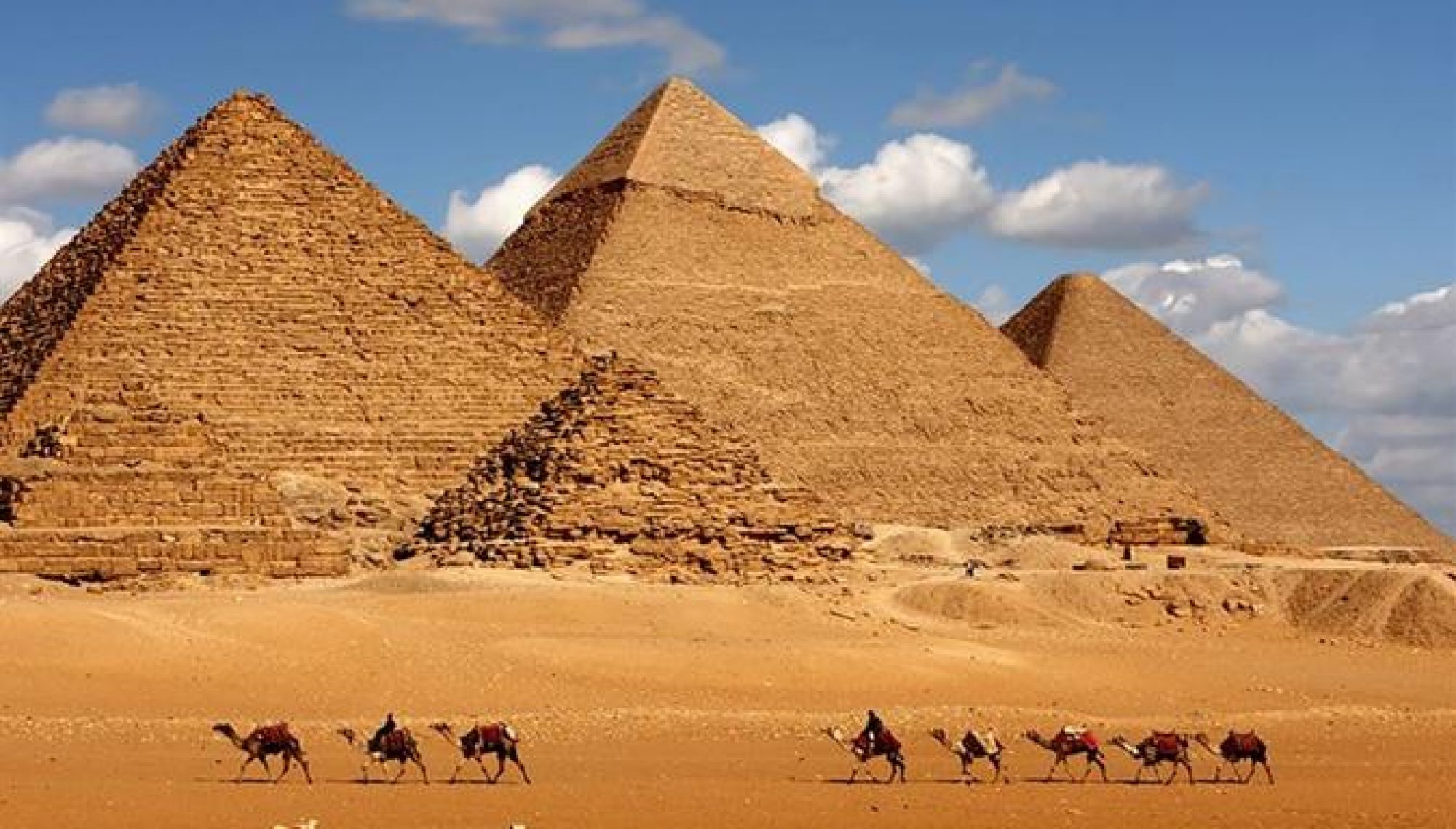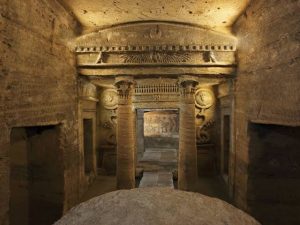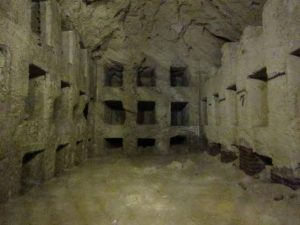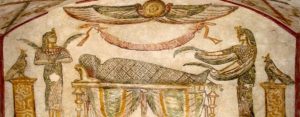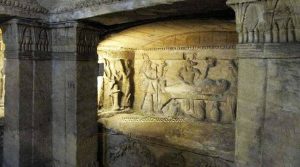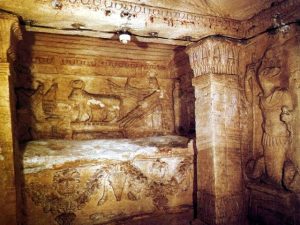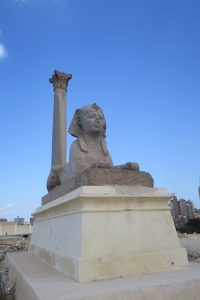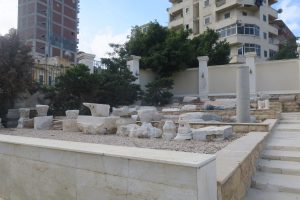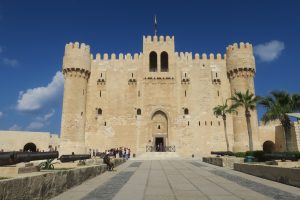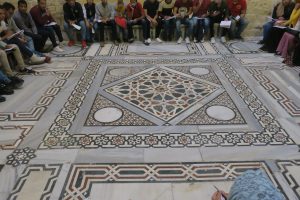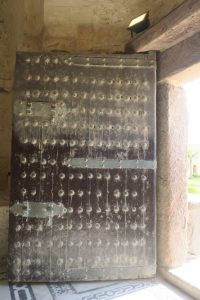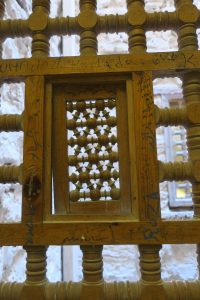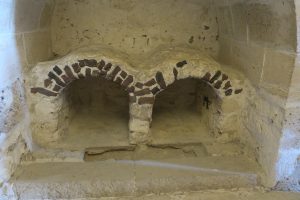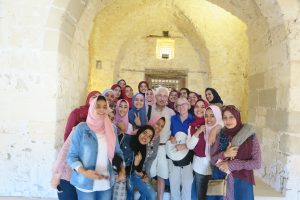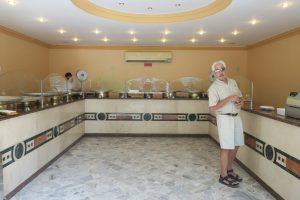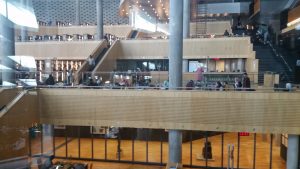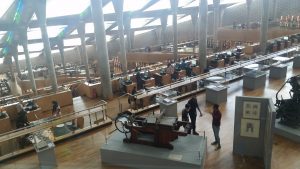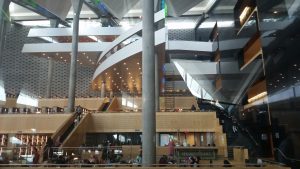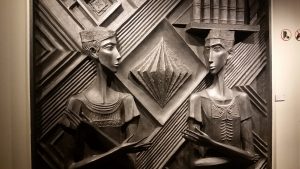We were up early to meet our new guide, Nahed, at 6:30. We were headed to Alexandria which is about 2 1/2 hours away. Alexander the Great established Alexandria as the new capital after he conquered Egypt. It is right on the Mediterranean Sea so it was relatively close to Greece. Alexander died young and the Greek territories were split amongst his generals. Ptolemy was awarded Egypt. The Greeks integrated themselves into the Egyptian culture and ruled until the Romans conquered Egypt.
Alexandria is a very industrial town with lots of factories. It doesn’t have a lot of historical landmarks so one day is enough to see the important sites. We started at the Roman catacombs or Catacombs of Kom El Shoqafa. We went down a circular staircase which wound around a large shaft, used to lower the bodies down to the tombs. The tombs were tunneled into the bedrock from the 2nd century to the 4th century. The tombs had a mix of Egyptian, Greek, and Roman influences. It was discovered in 1900 when a donkey accidentally fell into the access shaft.
The catacombs were named Kom El Shoqafa, meaning Mound of Shards, because the area used to contain a mound of shards of terra cotta which mostly consisted of clay jars and objects. These objects were left by those visiting the tombs, who would bring food and wine for their consumption during the visit. The visitors didnt want to carry their containers home from this place of death, so they would break them. At the time of the tombs discovery heaps of these broken plates were found.
We couldn’t take pictures so here are some I down loaded from the internet.
While we were at the catacombs our driver bought us some falafel, traditional middle eastern breakfast food. Rick really liked them. I actually thought they were ok so I think we will be making falafel when we get home.
Next we went to the Temple of the God Serapis which was an ancient Greek temple built by Ptolemy III (reigned 246–222 BCE) and dedicated to Serapis, who was the Greek version of Osiris and the protector of Alexandria. Today most of the temple is gone. The temple contained a large library. According to Nahed, after Cleopatra’s library burned, Mark Antony gave her 45,000 books for a wedding present. These books were housed at this temple. Pompey’s Pillar still stands in the center of the temple. It is a Corinthian column that was built in 297 AD, commemorating the victory of Roman emperor Diocletian over an Alexandrian revolt. The Serapeum of Alexandria was closed in July of 325 AD, likely on the orders of the Christian Emperor Constantine during the persecution of pagans in the late Roman Empire. Then in 391 AD religious riots broke out during which the temple was destroyed.
Next we went to the Citadel of Qaitbay, a 15th century fortress. It was considered one of the most important defensive strongholds, not only in Egypt, but also along the Mediterranean Sea coast. It was erected on the exact site of the famous Lighthouse of Alexandria, one of the Seven Wonders of the Ancient World completely destroyed by several earthquakes.
There were several school trips to the citadel. It was mobbed with kids. We were swarmed by many young girls eager to take our pictures taken with them. We spent 20 minutes making photographs with the girls. It was actually a lot of fun.
Off to lunch… Next to the restaurant was a bakery. Here is Rick buying some Egyptian pastries afterward.
We finished our Alexandria tour with a visit to the library. The library in an enormous, state of the art facility. It has shelf space for eight million books and the main reading room covers 220,000 sq ft on eleven cascading levels. The complex also houses a conference center, specialized libraries for maps, multimedia, sections for the blind and visually impaired, special needs individuals, four museums, four art galleries for temporary exhibitions, 15 permanent exhibitions, a planetarium and a manuscript restoration laboratory. The library’s architecture is striking. The main reading room stands beneath a 32-meter-high glass-panelled roof, tilted out toward the sea like a sundial and measuring some 450 ft. in diameter. The exterior walls are made of gray Aswan granite carved with characters from 120 different human scripts.
After the library we drove back to Cairo. It was a long but good day. That evening we went to the Egyptian restaurant in the hotel. They are starting to get to know us.
